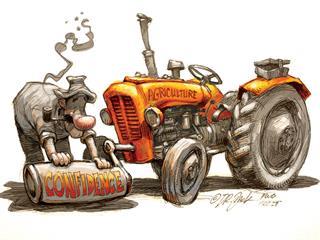Lately, much rhetoric has been expounded by academics, politicians and others with little practical farming experience about the role of small-scale agriculture in feeding the world. Farm size, of course, is a relative concept. As half of South Africa’s commercial farmers generate a turnover of less than R500 000 per annum, many of them could be classified as small and highly vulnerable to setbacks. These include floods, droughts, untimely frost, and disease, any of which could destroy an entire crop and a year of expensive inputs.
Government does not need to create small farms; small farms happen automatically as financial realities, spearheaded by inflation, escalating production costs and erratic markets, force uneconomic units out of the system. And with them goes the economies of rural towns.
Examples and challenges
Proof of this is that, after the Subdivision of Agricultural Land Act (which aimed at stopping the indiscriminate cutting up of land into unviable farms) came into force in 1970, the country’s 150 000 commercial farmers of the time dwindled to fewer than 40 000 by 2010. This despite plenty of state support for farmers, an excellent agricultural extension service, good formal education of farmers via dedicated colleges, and a reliable road and rail transport network.
Considering the above, along with the fact that South Africa’s climate and soils make for a largely farming-unfriendly environment, it is hard to fathom how really small farmers can make it when all pointers say bigger is the only way. After all, South Africa’s population of commercial farmers continues to dwindle alarmingly. A dangerous perception is being created that it’s possible to earn a living on one or two hectares.
Africa’s arable land is mostly in a handful of countries such as the DRC, Congo, Mozambique, Zambia and Angola. South Africa, as a low-rainfall, water-scarce country, has a total of perhaps 8% that can be regarded as irrigable. Most of the rest is semi-arid to arid, good only for extensive livestock production, which is the system least likely to sustain small farmers and most likely to over-exploit the natural resources.
Large tracts of farmland still bear the scars of overstocking and wrong land use, such as ploughing in marginal rainfall areas, inflicted on it by a previous generation of farmers fighting the elements.Few jobs are more demanding than that of a small farmer, as shown by the number who have flocked from the hinterland to the mines. The exodus reached its peak during the Great Depression, but is by no means over.
As it is impossible to earn a living from a few cattle, sheep or goats, the only realistic options for small-scale farming are cropping or poultry. The former would be viable only where water is sufficient, while the latter would have a chance of success only where markets are big and close by to offset the high cost of feed. Fruit is a long-term alternative but highly
capital-intensive.
These are not the only hurdles. According to an experienced fresh produce agent who buys and sells crops from small producers along the coast between East London and George, the big supermarkets have done more to kill this sector than to help it. In this region, at least 60ha are required to grow vegetables under irrigation profitably. While the bigger farmers truck their produce to Johannesburg, where the demand and money are, those in the 5ha category simply cannot survive due to high labour, fertiliser and transport costs. Neither can they afford the costs of supermarket audits and certification. The result is that niche products offer the only real hope.
This fresh produce agent does not believe that plans to lower certification standards to accommodate small players will materialise. On the contrary, food safety standards would have to be raised to counteract the increased risk of crops cultivated under unsophisticated conditions.
Minimum requirements
Small-scale farming is a poverty trap unless the following requirements are met:
- Substantial, sustained state subsidies;
- Plenty of affordable irrigation water;
- A committed, well-trained agricultural extension and technical service;
- Training in methods that avoid the depletion of soils caused by mono-cropping;
- Good roads and transport vehicles to get the produce to the market;
- A ready market with spending power;
- Decent prices for the produce;
- State intervention to prevent dumping of surplus crops from other areas. However, interfering with the free market usually has unintended, negative consequences;
More outgrower schemes such as those run by the tobacco industry, keeping in mind that tobacco, being a high-value cash crop, could entice farmers away from planting staple foods. As a senior bank executive recently noted, if small-scale farmers wish to become profitable – or part of the commercial value chain – there are some basics they need to apply to their operations. Planners in the meantime must take note of future trends in markets and consumer needs.
The only way forward
According to presentations at the recent International Food and Agricultural Management and CCA Agribusiness and Food World Forum Conference in Cape Town, Africa is experiencing rapid urbanisation, with more than 50% of the continent’s population already living in cities. Demand for milk, eggs and meat is increasing, and consumers who can afford greater choices are likely to change from traditional markets to retailers. Studies suggest that the demand for, and subsequent production of, processed goods is set to climb rapidly.
The above suggests that rather than trying to keep rural people from moving to the cities by creating unsustainable agricultural smallholdings in marginal areas, the focus should be on establishing more industrial jobs, including in value-adding and competitive agricultural processing. The emphasis should also shift from full-time farmers to part-time farming, as is the case in the USA and Japan, where a large percentage of farmers are involved in off-farm occupations to augment their incomes.
Unfortunately, this is only possible in a flourishing national economy where there is a demand for goods and services.
Certainly, there are many successful small farmers and they must be helped to stay on the land and expand. But the domestic farming industry is so brittle – despite showcases such as Nampo – that policymakers should not underestimate the role of the commercial sector, which is already efficient in the business of producing affordable food and foreign exchange.
The views expressed in our weekly opinion piece do not necessarily reflect those of Farmer’s Weekly.













